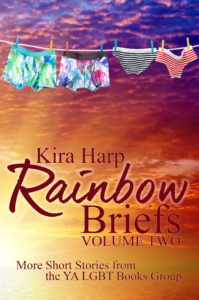For me, the point of view my books end up in isn’t a planned decision. As a pantser, all my books begin as a voice in my head telling me a story.
Sometimes it’s in third person, saying, “The teacher’s eyes snapped open and he made a small sound between pain and surprise. For an instant, Mac met an intense blue gaze.” And Life Lessons unfolds in alternating third person.
Sometimes it’s in first, a man’s voice telling me “When you’re the Alpha of a werewolf pack, even a pack as non-traditional as mine, you have to be Alpha. No doubts, no worries, at least where the lower-ranked wolves can see you. I’d been faking it all week, ever since pack leadership had fallen into my hands.”
That one was Aaron, in Unexpected Demands, the second book of my werewolf series. The first book was alternating third person. I told Aaron I’d represent him fairly in third person, if he’d just let me. He said no. Emphatically. And I ended up with one first-person book in a third-person series.
 Yes, writers are a bit odd sometimes. We hear voices.
Yes, writers are a bit odd sometimes. We hear voices.
Everyone’s welcome to have preferences, even no-go choices. Some people won’t read present tense. Or first person. Or omniscient. Which is fine. After all, there are far too many good books to force yourself through something you don’t enjoy.
As a reader, though, I’ve come to appreciate all the ways that different POVs work in different stories. I do love alternating deep third person. In so many stories, it gives us an emotional connection to the two main characters. As an author, it lets me show readers what each man sees in the other. It lets me connect with the emotions of a man going through a difficult time, and also another man having to watch the guy he loves go through something hard. Many of my favorite books are written this way.
But sometimes, having only one third person viewpoint helps the story. Think about Captive Prince by C.S. Pacat. We see the story only through Damen’s eyes. If we knew what Laurent was thinking, planning, feeling? So much of the surprise and tension and excitement of the story would be lost.
First person is great for character voice. In Muscling Through by J.L. Merrow. Al’s gentle, open, candid and sweetly naive voice gives the story poignancy. Or Marshall Thornton’s Nick Nowack, and Jordan Castillo Price’s PsyCop. The flavor of Nick’s thoughts, the quality of Vic’s world view, make those stories what they are.
There are books in alternating first person. This gives us a ride inside the head and life of each character in turn. Especially when those characters are very different, in age or experience or temperament, it adds interest by shifting our view of events in a way alternating third doesn’t. My favorite is the fantasy Melusine by Sarah Monette, where a sophisticated gay wizard, with a dark past, alternates steering our perceptions with his foul-mouthed, warm-hearted brother.
Omniscient, even when done well, sometimes feels cooler to me and less emotionally engaging. Until I remember that some of my favorite fantasy stories are omniscient. It’s less common in romance, but Nora Roberts has on occasion pulled me into a story with one.
Past tense is the most common but present tense adds immediacy. A lot of Young Adult fiction is written in present tense, giving it a tension and forward momentum and lack of perspective that fits the stories. Sometimes emotion can be gripping in present tense. I wonder if Dan’s pain, in Dark Horse by Kate Sherwood, would’ve made me cry, if I hadn’t been there in present tense as he felt it happen.
(Kate Sherwood is also the only author to put a lump in my throat in second person present tense though – with the short story Rough Broke where the tense reads like a memory or a dream of past pain. So maybe she’s just that good.) 
The issue of point of view came to me as I’ve been working through editing short stories for my next YA freebie collection, Rainbow Briefs 2. I realized how many I’d written in first person, and even in present tense, and wondered why these photo prompts so often pulled that kind of story out of me. I’m still not sure why, but I’m not fighting it. The stories will be what they want to be, and hopefully there are many readers out there who enjoy all the variations on the stories we write.
-Kaje Harper
April 2018


I haven’t read Rough Broke…sounds intriguing!
Thanks for sharing. This is a fascinating subject and it’s always interesting to know how authors build their characters and make decisions about POV.
I, myself don’t have a preference when it comes to POV. I like to go with the author’s flow and get into the head of the character the way the author intends to. Sometimes I see complains from the reviewers when there is no alternating POV in the story. I guess there must be the need to know the thoughts of all the parties involved.
I have to say though, I have read a short story once, it was written in the second person in past tense. It was quite a switch and it took a bit taking used to.
Thanks again for your thoughts. Greatly appreciated.